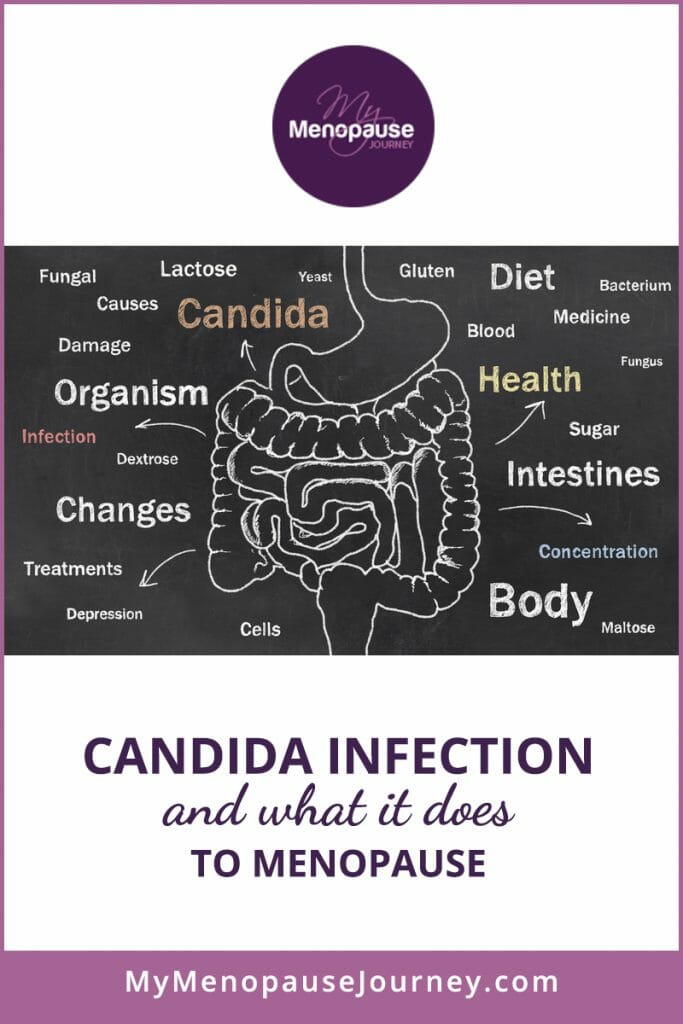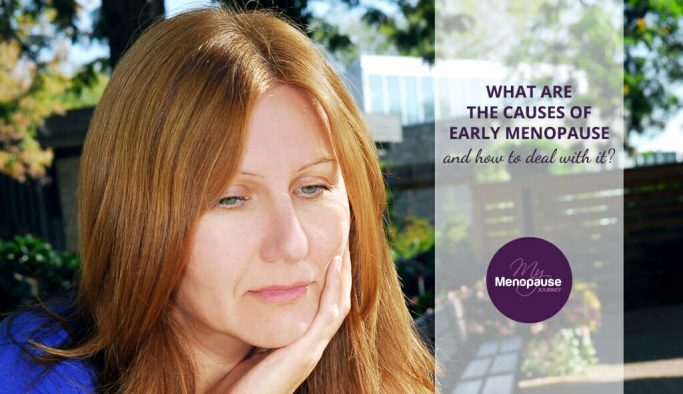Relieve stomach discomforts, curb sugar cravings, ease anxiety and boost your energy by healing yeast infections in menopause!
Yeast infections can happen at any time in your life, especially when you’re stressed. But do you know that it’s twice more common during menopause?
From time to time we have nagging symptoms. Some aches, itchiness, bloating, fatigue and food cravings now and then. We often shrug it off as a “normal part of life”.
Fact is, yeast infections can cause all these discomforts. There are many kinds of yeast infections, and one of the most common is candida overgrowth.
Candida infection symptoms are numerous, and it might be the culprit why you’re feeling unwell.
If you’re not sure if it’s candida or not, join us in the article, and let’s find out more about candida overgrowth in menopause. Let’s also discover its kinds, the signs and symptoms, its infection and how you can prevent and treat the condition.


What is Candida Overgrowth?
Candida overgrowth, candida infection, or candidiasis is caused by an overgrowth of fungal yeast called candida albicans. These fungi are found in your body, and they occupy a lot of your organs. They are in your gut, skin, mouth, armpits, feet, lungs, bladder and genitals.
Just consider your body as a large estate, and candida albicans are your tenants. Candida taking permanent residence in your body isn’t a bad thing. They’re not “villains” as they’re portrayed!
Candida albicans are naturally good and this is why they’re called beneficial pathogens. When they don’t overgrow and their population is controlled, they work together with other friendly bacteria to:
- Help your body identify “bad” bacteria and prevent them from entering your body
- Decompose dead cells and tissues
- Boost your digestion
- Absorb vitamins and minerals better for more energy
So, if candida are good guys on and inside your body, when do things become imbalanced?
There’s a good old saying, “anything in excess is bad” and this goes the same for candida.
Candida becomes destructive when they multiply at rapid rates, and they become overpopulated in your body. They will conquer and dominate by releasing a toxic waste called acetaldehyde.
Acetaldehyde loves free radicals and toxins, so you’ll get pools of these harmful compounds inside you. Your ever-dependable liver will try to flush them out, but after a while, it gets tired. Candida continues its conquest in your body, destroying your balance and sweeping off your normal flora – which gives rise to your discomforts!
The Centers for Disease and Control Prevention (CDC) classified candidiasis in three main forms:
- Oral Thrush. You’ll know when you have oral yeast infections if you have creamy lesions on the roof of your mouth, tongue, inner cheeks, gums or tonsils. Lesions usually have cottage-cheese or curdled milk appearance. You may also experience inflammation of your lips, difficulty swallowing and pain in your oral cavity. If it reaches your throat (which we hope not), it’s called candida esophagitis.
- Genital Candidiasis. One of the most common kinds of candidiasis, and there’s a good reason why! Your reproductive organs are very sensitive to changes in pH levels, and candida disturbs pH balance big time. You’ll also have cheese-like discharge, redness and itching or burning feeling if you have a yeast infection. Peeing can also be difficult or painful.
- Invasive Candida Infection. Invasive candida infection is systemic. Candida goes with your blood, so this means you can have symptoms in any part of your body. Doctors find it challenging to pinpoint. One of the unique symptoms of this candidiasis is a persistent fever that doesn’t respond to antibiotics.
Experts say, if you have a weak immune system, you’re more at risk of experiencing yeast infections in menopause. And unfortunately for us ladies, candida is more common in women than in men. Statistics says 75% of women develop vaginal candida infection at least once in their lifetime.
How Does Yeast Infections in Menopause Develop?
Vaginal infections are common before periods and throughout menopause. Lifestyle may influence this, but do you know that hormones have a lot to do with it?
Highs and lows in estrogen are one of the few reasons why you may experience candida overgrowth in menopause. A study from Iowa in 2000 shares that estrogen actually loves to nurture candida. Another research from the University of Illinois backs this up. It explains that estradiol (a kind of estrogen released during menopause) supports the formation of candida in the body.
If you have estrogen dominance (ED) (when estrogen becomes dominant because of decreasing progesterone), your chances of candida overgrowth in menopause may increase.
Estrogen is also the maintenance personnel behind your normal flora, especially in your vaginal area. Your estrogen makes sure that the lady down there is slightly acidic. So, it can kill off bad bacteria and protect you from infections.
ED makes your pH too acidic, so you’ll break down sugar faster (yes, there’s sugar in that part of our body). Candida rejoices and feasts on your sugars.
So, what do you do? It’s pretty simple, acidity = alkalinize. But wait there! Doctors say too much alkalinity isn’t good either. This is because it puts you at risk of urinary tract infections. According to experts, the best thing to do is to keep pH levels in balance. Not an easy feat but definitely worth working for.
Aside from balancing your pH levels, it’s also important to address estrogen dominance. Start by taking a menopause test to know your estrogen to progesterone ratio. To balance your hormones, start by overhauling your diet. Go organic to avoid fake hormones, like xenoestrogens. Live healthy to flush hormone-disturbing toxins. Use adaptogens and supplement if needed. You can read our article, Hormone Balance for a Better Menopause Journey to get more tips!
If you think it ends here, we have another interesting story…
Some scientists say your vagina has a mind of its own. That’s pretty interesting, right? It even has its own immune system to prevent infection. A study published in 2010 says that if estrogen is in balance, you will be able to protect your reproductive organs better. However, when it’s high (such in the case of ED), it lowers your vagina’s immunity and protective qualities.
Your progesterone, on the other hand, makes sure you don’t get yeast infections. Scientists from Portugal and the UK did a research in 2014. They discovered that the hormone can weaken Candida’s ability to infect the body. Progesterone alters the genetic makeup of Candida so it doesn’t become potent.
Hormone Replacement Therapy (HRT), especially estrogen-only therapy, has been found to increase yeast infections in menopause. According to a study in 2011 from the University of Sydney, postmenopausal women who took hormone replacement therapy (HRT) were more likely to develop candida overgrowth.
7 Common Causes of Candida Overgrowth in Menopause
“If candida is essential in the body, why does it become an infection?” Good question! There are several triggering factors leading to candida overgrowth in menopause. Here are some of them:
- Chronic stress. Long-term stress stimulates our body to release a lot of cortisol. This hormone suppresses our immune system and increases circulating sugar.
- Long-term use of antibiotics. Self-medication is definitely a big NO! Taking antibiotics for prolonged periods of time can wipe out our healthy or friendly bacteria. This allows candida to grow unchecked.
- Excessive use of aspirin. Aspirin is a medication with many side effects. Even a short-term low-dose aspirin can damage our intestines. This creates unfriendly environment for good bacteria and fosters an environment where bad bacteria like Candida can grow.
- Eating too much sugar. Candida needs carbs to provide them with energy. This means sugars like glucose, fructose and sucrose. They use this energy to grow and to build their cell walls, which are comprised 80% of carbohydrates. So, when you’re eating too much sugar, you’re basically feeding Candida.
- Low immune system. Candida is kept in check by our native bacteria and immune defense. If a person’s immune system is weakened or suppressed, there is increased growth and survival of Candida.
- Poor hygiene. Poor hygiene doesn’t just mean not taking a shower. Being too ‘clean’ can actually cause more problems. This is because you are diminishing your body’s normal flora. Many commercial products we use are also friendly-bacteria killers.
- Use of tight or damp clothing. Bacteria love moisture. They also like to live in dark and humid places. If you wear tight clothes, sweating increases and you create a great home for candida.
How Will I Know If I Have Yeast Infection?
This is quite tricky because most of the symptoms of candida overgrowth are general, especially in systemic yeast infection. They also resemble the symptoms of other conditions like Irritable Bowel Syndrome (IBS), Crohn’s disease, Chronic Fatigue Syndrome, Fibromyalgia and more!
Some of the most common signs and symptoms of candida overgrowth in menopause include:
- Fatigue
- Food cravings
- Brain fog
- Digestive problems
- Allergies
- Joint pain
- Mood swings
- Headaches
- Dizziness
- Sleep disturbance
Local candidiasis can happen in the gut, skin, lungs, mouth and other organs. Positive Health Wellness has a full list of their yeast infection symptoms.
In addition to our symptoms, it’s also a good idea to check for candida in our body, and we don’t have to go to the doctor for this! We can do it at home, and it takes only a few seconds to a minute to do the test! Check out this video below to know how [7:03]:
This is another great video from FitLifeTV, which will teach us how to check our pH balance and what the result implies. You’ll basically learn how to use pH test strips in seconds!
Bring back the balance of acids in your stomach. Learn how to build healthy levels of Hydrochloric Acid for your gut today in this video.
Aside from all these things that you can do at home, you may also visit your doctor for advice. Some lab tests that may be prescribed to check for Candida include stool testing, serum testing and candida DNA test. There are also gut testing kits you can do at home, like this one from Verisana.
How Do I Prevent Candida Overgrowth in Menopause?
Do you know that we can put candida under harsh conditions, so it doesn’t thrive? Yes, we can starve, suffocate and eventually get rid of candida overgrowth with natural remedies!
How? Find out below!
Three Natural Remedies for Candida Overgrowth
Starve Candida!
- Avoid starchy foods, artificial sweeteners, alcohol, grains, dried fruits, cured meat and dairy. These foods make it easy for candida to multiply and thrive!
- Eat more good fats like olive and coconut oil.
- Start chewing on vegetables like asparagus, cabbage, garlic, olives and onions.
- Eat fresh, grass-fed and organic meats, wild salmon, herring, sunflower seeds, walnuts, and non-glutinous grains.
- Add some healthy herbs like basil, cinnamon, paprika, thyme, rosemary.
- Have more bone broth. Bone broth has gut-healing properties. It is rich in collagen which helps rebuild your gut lining. Bone broth has zero sugar so it will starve candida, bringing back their population to normal. It also relieves gut inflammation, which sometimes causes candida overgrowth.
- Check out some food choices that you may eat and those that you need to avoid.
Crush Candida Overgrowth!
Reinforce a healthy diet with helpful herbs to totally crush excess candida. Below are some anti-fungal herbs that can get rid of fungi strains like yeast!
- Turmeric Root
- Oregano Leaf
- Garlic Bulb
- Peppermint Leaf
- Fennel Seed
- Grapefruit
- Olive Leaf
It’s easy to make these herbs part of our life. We can include them in our meal preps, make teas, tinctures and homemade remedies out from them.
These herbs have powerful anti-fungal, antibacterial, anti-inflammatory and antioxidant properties. They also work to detoxify the gut, making sure that bacteria inside is regulated. Candida can build resistance easily, so you might want to use these herbs alternately.
Hygiene is also very important. Revamp your routine and see what works for you. Stress is an essential thing to focus on. Make sure to do some stress relief techniques. This may include yoga and meditation, walking, gardening, strolling or whatever makes you happy and rejuvenated!
Suffocate Candida!
This is the “rebuilding” phase of your quest to get rid of candida overgrowth in menopause for good! Once you’ve followed everything above, make sure to restore and reinforce good bacteria, especially in your gut.
- Eat more probiotics rich foods like kimchi, kefir, miso soup and sauerkraut. You can also use a natural probiotics supplement. Probiotics are live yeasts that restore balance in your flora by placing more good bacteria where your candida overgrowth started. They also stop your candida from growing too rapidly. In the stomach, the natural acetic and lactic acid in probiotics helps maintain our acidity. However, you may need to use the right probiotics for it to be effective.
- Spirulina is also a good food to consume to prevent and suppress candida overgrowth. This superfood has strong antifungal and antibacterial properties that hinder candida from multiplying in our body. Aside from dietary intake, you can also take natural and organic spirulina supplements.
- If you need a hand at getting rid of yeast infection, a cousin of spirulina called chlorella can help. This superfood has the highest chlorophyll content among all superfoods. Chlorophyll maintains our natural digestive enzymes to speed up digestion, heal the gut, flush out bad bacteria and strengthen the immune system.
- Make sure to maintain a no sugar, no booze, no gluten and no processed foods diet throughout this rehabilitation phase.
- Consider a liver detox. Yeast leave behind lots of harmful toxins, which you may want to get rid of. They can cause rashes, acne and decreased energy.
Diet is one of the most important things in curing candida overgrowth in menopause. Candida feeds on what we have inside our body, so we must eliminate their food.
Candida overgrowth affects women of all ages, and it’s not something to be embarrassed about. According to statistics, around 75% of women develop candida infection at least once in their lifetime. If you feel like you have it, learn to know the root cause of the problem and evaluate what you can do to tame your candida and keep them as allies instead of an enemy!
References:
draxe.com/candida-symptoms/
cdc.gov/fungal/diseases/candidiasis/index.html
cdc.gov/fungal/diseases/candidiasis/genital/index.html
thecandidadiet.com/what-is-candida-albicans/
mindbodygreen.com/0-8376/10-signs-you-have-candida-overgrowth-what-to-do-about-it.html
msdmanuals.com/professional/infectious-diseases/fungi/candidiasis-invasive
immunology.org/public-information/bitesized-immunology/pathogens-and-disease/candida-albicans
👉 What to Do Next
Don’t go just yet — especially if you’ve been feeling off and no one’s given you real answers.
Go to the START HERE page.
It’s where things begin to feel clearer. No more second-guessing, no more sorting through conflicting advice. Just calm, honest support for where you are right now.
And if you haven’t yet, download the FREE GUIDE.
It’s quick, clear, and made to help you feel better — without having to turn your whole life upside down.


Gita is the founder of My Menopause Journey. Since 2014, she has been supporting midlife women by sharing hard-earned learnings from her own experience. To advance her knowledge, Gita puts a lot of her time and effort into understanding the broad spectrum of women’s health. She immerses in extensive research about the physical, mental and emotional aspects of menopause. Gita believes in the life-changing power of healthy, holistic living — this is where she anchors her message to all women. Learn more about her marvelous mission in About us - My Menopause Journey.






